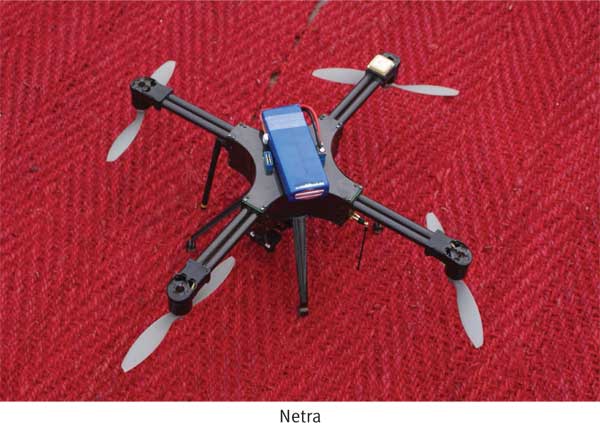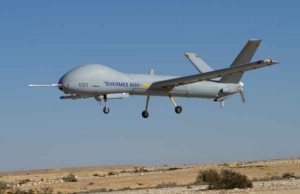Massive Market
However, the pace of India’s UAV acquisitions is likely to quicken over the next five years or so and the size of the Indian market during the same period is estimated at over $2 billion. According to an analyst of the Teal Group, quoted in the Times of India last year, “We see a growing market in India — 50 Medium-Altitude Long-Endurance (MALE) UAVs, 60 Navy UAVs, 70 Air Force tactical UAVs, 100 Army tactical UAVs and 980 mini-UAVs over the next decade.” Indeed, the armed forces need UAVs of varying size and performance to meet requirements like border surveillance, communications and weapons delivery. The Indian Navy is in search of MALE UAVs and ship-borne rotary-wing UAVs and wishes to enhance its short-range capability. The Indian Army hopes to augment its existing fleet of Searcher Mk 2 UAVs and procure hundreds of mini-UAVs. Its priority is to keep a close watch on the borders with Pakistan and China. The IAF would like to bolster its MALE UAV holdings and is particularly keen to acquire UCAVs.
As demands for UAVs inevitably multiply, the danger is that each service will seek to fulfil its own requirements in isolation…
India’s paramilitary forces also wish to create their own UAV units for dedicated internal security duties because the National Technical Research Organisation (NTRO) is unable to meet their requirements. The Central Reserve Police Force (CRPF) already has a small fleet of Netra mini-VTOL surveillance systems for intelligence gathering. Netra, a quad-copter UAV, was developed by the DRDO and is produced by Mumbai based private firm ideaForge. It weighs only 1.5 kg and is man-portable. After take-off, it can fly a distance of 2.5 km at an altitude of 200 m. The CRPF is keen to acquire larger fixed wing UAVs, perhaps Nishants or Herons, for use in Naxal-affected areas of Chhattisgarh and Jharkhand. Although UAVs have not proved particularly useful in penetrating the dense foliage of the tropical rainforests, the DRDO is working to resolve the issue and hopes to have a solution within a couple of years.
The Border Security Force (BSF) also wishes to acquire its own UAVs to monitor the Western sector. And the Indian Coast Guard (ICG) needs UAVs for coastal and offshore surveillance, especially on the Western seaboard which has become a major focus area following the Pakistan-sponsored Mumbai terror attacks of November 2008. Even police forces desire these devices for crowd monitoring and disaster management.
Why are UAVs in such demand? Their main role is gathering image intelligence. Sensors may include the Electro Optical TV/IR system, Synthetic Aperture Radar (SAR) facility and Maritime Patrol Radar (MPR). Their other important role is to gather signal intelligence. They can be endowed with ELINT, COMINT & ESM capability, plus a communication relay package. ELINT sensors help detect, identify and classify Radio Frequency signals and locate hostile emitters while COMINT systems help to intercept and decode speech communication. In addition, ESM sensors can fingerprint various surveillance and weapon systems so as to evaluate their capability. Thus UAVs can build a comprehensive picture of the enemy and his deployment as a prerequisite to action.
However, as demands for UAVs inevitably multiply, the danger is that each service will seek to fulfil its own requirements in isolation. There is urgent need to coordinate and synergise procurement efforts among the three services, and perhaps even the paramilitary and police forces, so as to avoid needless overlap and wastage of scarce resources. Even second and third line maintenance facilities can be shared to avoid wasteful expenditure and save precious foreign exchange. It must also be remembered that the aim of most unmanned surveillance missions is to gather actionable information, based on which sound decisions can be taken. In most missions, such actionable information may be as little as 0.5 per cent of the massive data stream. The three services can coordinate training of analysts and synergise information extraction so as to obtain the maximum benefit.
The Indian Navy too has an extensive ocean area to patrol and would love to acquire the Northrop Grumman MQ-4C Triton…
Domestic or Foreign?
Ideally, the lion’s share of the country’s growing UAV requirements should be met by domestic production. But the list of delayed or failed indigenous military products is already long and it seems fairly certain that UAVs will continue to be imported for many more years. Israel currently is the main source of India’s military UAVs. Since Israel is more than willing to supply advanced systems and has even offered joint development and production of some UAVs, India needs to keep track of the former’s latest offerings. For instance, in early 2014, IAI rolled out the Super Heron, a heavier model with a more powerful engine than the Heron. Its cruising speed is increased to 210 kmph, which enables a higher climb rate and enhanced manoeuvrability. Its enhanced payload and endurance also facilitate long-duration maritime patrol missions.
But India should not be tied to a single supplier. Therefore, it could also consider the Elbit Systems Hermes 900 MALE UAV. The Hermes 900, with a gross weight of 1,100 kg and payload capacity of 300 kg, proved its worth in Israel’s Gaza operations in July. It has a cruising speed of 112 kmph and endurance of 36 hours. All large Israeli UAVs are theoretically capable of carrying weapons and although the Israelis have never publicly acknowledged it, they probably frequently use them for armed attacks.
The other major supplier is the US – the country with the most advanced military technology in the world. Many high-end UAVs in the market are supplied by American firms. The vast areas that India’s military must keep under constant surveillance certainly need capable systems such as the Northrop Grumman RQ-4 Global Hawk. The Indian Navy too has an extensive ocean area to patrol and would love to acquire the Northrop Grumman MQ-4C Triton operating in conjunction with its fleet of eight Boeing P-8I Poseidon Maritime Patrol Aircraft (MPA). However, the chances of India getting the most advanced systems it wants from the US without being subjected to irksome restrictions are remote.
The chances of India getting the most advanced systems it wants from the US without being subjected to irksome restrictions are remote…
Burgeoning Demand
UAVs and UCAVs are in great demand everywhere mainly because they neither put a pilot’s life at risk nor are they subject to physiological limitations. They are also usually cheaper to buy and fly than manned aircraft. But their shortcomings must not be glossed over and they are unlikely to completely replace manned aircraft in a hurry. UAVs are complex systems, usually less reliable than manned aircraft and prone to accidents. Since they cannot detect most ground and airborne threats, they may never be fully dependable in all types of operational situations. They neither have self-protection nor quick getaway capability. While their feats may seem impressive, they have never been tested in combat involving evenly matched adversaries. Rather, they have mostly been employed by overwhelmingly superior military powers such as the US and Israel in asymmetric operations against opponents like Al Qaida and Hamas who do not possess air capability worth the name. The story would be quite different in an India versus China situation.
Still, UAVs are useful devices that can even be true game changers and decide the outcome of future conflicts. That is why they are proliferating rapidly. Some experts believe that within a decade practically every country in the world will be able to build or buy UAVs.
At present, India’s military UAV requirements are being only partially met. Indeed, current holdings barely scratch the surface of the country’s immense needs and there is plenty of scope for new inductions. The DRDO needs to put the development of UAVs on fast track. The existing gaps in the development of advanced seekers, sensors and actuators must be bridged and production of a range of capable models must be commenced so that the defence services and paramilitary organisations may be freed of their risky dependence on imports.






